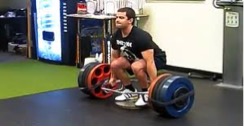Today’s guest post comes courtesy of Syracuse, NY based strength and conditioning coach Ricky Kompf. Ricky’s a good friend, works with a ton of youth athletes, and he knows his stuff.
What I like about his message is that he always stresses the basics first.
No fluff, no smoke and mirrors, no speed camps, and no agility ladders…;o)
Enjoy!

What Makes an Athlete Fast?
Speed is one of the most misunderstood aspects of training.
We get sold on fancy ladder drills, flashy sprint exercises and products that don’t work or are used incorrectly. After working with hundreds of athletes of all levels and skills I’m here to show you exactly what will make an athlete fast and what will actually allow you to hit those impressive numbers the elite level athletes hit.
It also goes without saying that, it takes work.
This will not happen overnight, you achieve this level of physical prowess from years of developing your body and consistently putting work in towards this every day.
Whenever an athlete comes to me, chances are they want to become faster and jump higher.
Speed is king, and rightfully so.
Speed is what sets you apart from the competition.
Speed is what gets you looked at for high level college programs.
There’s not much difference in skill between D3, D2 and D1 programs as there is a difference is speed and strength.
So, what makes an athlete fast?
1. Relative Strength

Relative strength is how strong you are relative to how much you weigh.
Without relative strength there is no speed.
Relative strength is what every quality of speed is built off of.
I hate to speak in absolutes but If you are not strong relative to how much you weigh you will not be fast. Strength is your horse power.

I promise I’m (mostly) not a Sith
Trying to sprint as fast as possible with low relative strength is like trying to go from 0-60mph in a Prius: You just won’t be able to get to top end speed quickly and your top end speed will be much slower than a sports car.
When you’re sprinting the only resistance you have on you is your body weight.
You have to propel your body forward in a fast-explosive manner and if you don’t have the relative strength to do so, all the sprints and speed & agility drills in the world won’t make you much faster.
FANCY SPEED EXERCISES AND AGILITY DRILLS WON’T ACCOMPLISH ANYTHING WITHOUT RELATIVE STRENGTH.
To put this into perspective, If you have two athletes who can deadlift 300lbs and one athlete is 150lbs while the other one is 250lbs, 10 times out of 10 the athlete who is 150lbs is faster.
Here are some indicators that I use to determine if the athlete is relatively strong.
Male Athletes:
- 15 or more chin ups
- 30 or more push ups
- Can trap bar deadlift over 2x their body weight for 3 or more reps
- Can back squat to box or safety bar squat to box 1.5x their body weight for 3 or more reps
- Can sled push 4x their body weight or more for 10 yards
Female Athletes:
- Can perform 5 chin ups or more
- Can perform 15 or more full range of motion push ups
- Can trap bar deadlift 1.5X their body weight for 3 reps or more
- Can back squat or safety bar squat to a box with 1.25x their body weight or more for 3 reps or more
- Can sled push 3.5x their body weight or more for 10 yards
This is all a general rule of thumb I use for my athlete to determine if they will respond well to an increase in speed work volume.
2. Mobility
Have you ever seen the athlete on the field who moves their legs super-fast but is one of the slower athletes or middle of the road?
It’s like they’re going nowhere fast.
Here’s why this is happening.
The athlete who takes the least number of strides to cover a certain amount of distance will always get to Point B first.
If your athlete is tight in the hips they won’t be able to cover max distance with every stride. This usually becomes an issue when an athlete’s hips are tight, restricted and weak.
Mobility also doesn’t mean just stretching, this is where flexibility and mobility get confused. Flexibility is the range of motion you can put your joins passively like reaching down to touch your toes. Mobility is the range of motion you can go actively, like driving your knee up as high as you can without moving your spine or going into a deep squat while keeping a neutral spine.
Flexibility is a component of mobility that you need in order to be mobile. Optimal stride length requires more mobility than flexibility.
Perform these mobility drills regularly to keep your hips in check while you become stronger and faster. These are all great examples where together they work on flexibility as well as mobility. This will help you become overall more mobile in the hips and moving better.
Speedy 7 Mobility Drills
Hip Series: Active Recovery
90/90 PAILs & RAILs
Standing Hip CARs
3. Core Strength
The role of the core while sprinting is to keep the midline stable while the arms and legs are in motion.
If your athlete does not possess the appropriate core strength it will result in energy leaks throughout their sprints and change of direction.
The core is used as a foundation in which force can be translated from the lower body to the upper body while sprinting. If the core and spine are not ridged while sprinting there won’t be as much force being put into the ground.
Even worse you’re at a much higher risk of injury.
If you ever watch an elite level track athlete sprint with their shirt off, their arms and legs are moving violently while the torso is perfectly still.
Without good core stability relative strength is low and mobility/movement quality is poor, which, if you’re paying attention are the first two qualities I spoke of.
Addressing all three should be a priority is every athletes program.
Check out these exercises that are great for core development:
Core Engaged Deadbugs
Plank on Knees While Breathing
Level I Plank March
4. A Faster Amortization Phase
The Amortization phase is the transition from an eccentric muscle contraction to a concentric muscle contraction.
This phase is a very fast isometric contraction that helps to transition the muscle to shorten while contracting.
This is commonly known as the stretch shortening cycle.
This is when a muscle rapidly lengthens then shortens. When the amortization phase is optimized and there is a very fast transition, the amortization phase is very short. When this happens there are more motor units recruited and more force is produced.
The shorter the transition from eccentric to concentric the more force is produced.
This happens on every stride once you’ve gotten into your cycle sprint (while you’re upright sprinting at your max speed).
Another common way to see this is when an athlete performs a vertical jump, as the athlete descends quickly and transitions from down to the upward phase of the vertical jump this is where the amortization phase comes in. The less time it takes to make that transition the more potential force is produced.
Ways to train this would be plyometrics, max effort sprints, longer distance sprints (20-40yd) and jumps where there is a focus on the transition from eccentric to concentric.
A few of my favorite ways to train this is by performing some of these following exercises:
1. 10-yd Push Up to Sprint/Mountain Climber Sprints
2. Hurdle Hop Variations to Push
3. Max Effort Vertical Jumps
4. 20 yd Sprints Flat Ground or Up Hill
5. Partner Sprint Chases
6. 30 yd Sprints
7. Double Broad Jumps
5. Strength in Specific Joint Angles and Technical Form
To develop strength in specific angles that the athlete will be in during a game I will often use contrast training, game speed exercises drills, and lifting exercises that are similar to positions an athlete will be in.
When it comes to speed, there’s nothing better than a heavy sled push or a sled drag.
Other good ones I like to use with a contrast are trap bar deadlifts and safety bar squats. All of these are great with mimicking the sprint and jump movements. Below is a video example of some contrast sets and specific joint angle exercises for speed.
Example #1
A1. Trap Bar Deadlift – 5×2
Rest 10-20 seconds
A2. Vertical Jump – 5×1
Rest 2-3 minutes before the next set.
Example #2
A1. Heavy Sled Push – 5×10 yards
Rest 10-20 seconds
A2. Push Up to Sprint – 5×10 yards
Rest 2-3 minutes before the next set
Example #3
A1. Safety Bar Squat to Box – 5×2
Rest 10-20 seconds
A2. Box Jump – 5×2
Rest 2-3 minutes before the next set
Example #4
A1. Chain Loaded or Banded Trap Bar Deadlift – 5×2
Rest 10-20 seconds
A2. Double Broad Jump – 5x(max distance)
Rest 2-3 minutes before next set
Strength Training Exercises in Specific Joint Angles
Heavy Sled Pushes
Heavy Sled Drags
Resisted Sprints
Trap Bar Deadlifts
These type of exercises and contrast sets should be performed during preseason after a full foundation has been developed during the offseason.
Note that these types of circuits are reserved for athlete who are older and more advanced with a good foundation of general strength and all the other qualities we went over already. Contrast training is not as effective without 3-6 months of general strength training. The sled pushes, sled drags, and deadlifts are exercises that should be staples every month in your athletes program.
Another way to work on this is to perform sprints and jumps to refine technique, having a coach’s eye to teach you how to sprint the correct way and jump the right way is the final piece to put all these qualities together. Sprinting, change of direction and jumping is a skill that will always require fine tuning and technique work.
About the Author
Ricky Kompf is the head coach/owner of Kompf Training Systems where we work primarily with team sport athletes like baseball, football, lacrosse and basketball.

He’s also a Head Trainer for a corporation for Bankers Heath Care.
You can give him a follow on Instagram HERE.
You can check him out on Twitter HERE.


